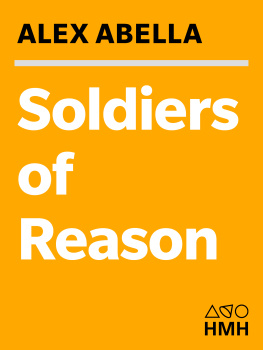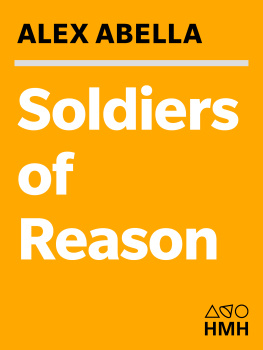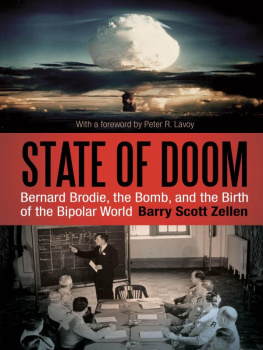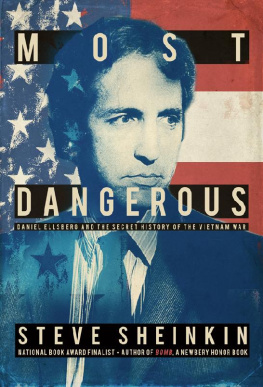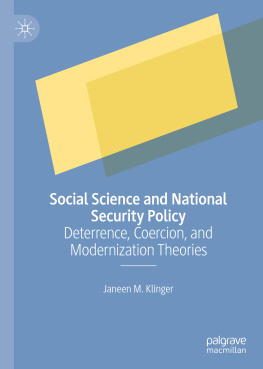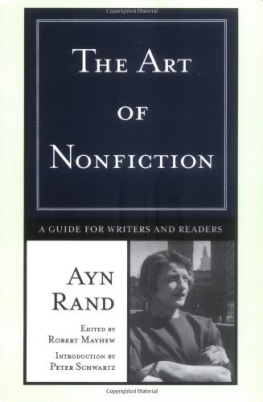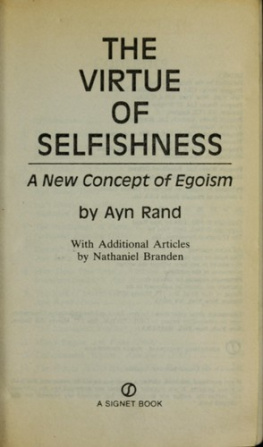Copyright 2008 by Alex Abella
All rights reserved. No part of this publication may be reproduced or transmitted in any form or by any means, electronic or mechanical, including photocopy, recording, or any information storage and retrieval system, without permission in writing from the publisher.
For information about permission to reproduce selections from this book, write to or to Permissions, Houghton Mifflin Harcourt Publishing Company, 3 Park Avenue, 19th Floor, New York, New York 10016.
www.hmhco.com
Library of Congress Cataloging-in-Publication Data
Abella, Alex.
Soldiers of reason: the RAND Corporation and the rise of the American empire/Alex Abella.1st ed.
p. cm.
Includes bibliographical references and index.
1. RAND CorporationHistory. 2. RAND CorporationInfluence. 3. Research institutesUnited StatesHistory20th century. 4. Military researchUnited StatesHistory20th century. 5. United StatesIntellectual life20th century. 6. United StatesForeign relations19451989. 7. United StatesForeign relations1989 8. United StatesMilitary policy. I. Title
AS36.R35A24 2008
355'.070973dc22 2007030691
ISBN 978-0-15-101081-3
e ISBN 978-0-15-603512-5
v2.1017
To my wife and children, who never wavered.
Ad astra per aspera.
Killing, too, is a form of our ancient wandering affliction.
R AINER M ARIA R ILKE
The Matrix is everywhere. It is all around us. Even now,
in this very room. You can see it when you look out
your window or when you turn on your television.
You can feel it when you go to work... when you
go to church... when you pay your taxes.
The Matrix (1999)
Reasons dream creates monsters.
F RANCISCO J OS DE G OYA Y L UCIENTES
Foreword
If we had lost the war, wed all have been
prosecuted as war criminals.
A IR F ORCE G ENERAL C URTIS L EMAY ,
in The Fog of War
I FIRST BECAME aware of RANDs existence in the cauldron of one of the most controversial conflicts in modern American history, the Vietnam War. The occasion was a rally at Columbia University in 1970. Two years earlier, New York City police had brutally ended a controversial student occupation at our Morningside Heights campus, resulting in hundreds wounded and arrested. My turn to get my share of abuse came on a sultry April night, when again New Yorks finest were summoned to end an antiwar protest that concluded, like so many of the era, with shattered windows, burning trash cans, clouds of tear gas, and the thumping of heads by police clubs to the cry of Up against the wall, m... f... !
Some of my codemonstrators had procured Molotov cocktailsor at least, what they thought were suchand ran to toss them at the building housing computers doing work for the RAND Corporation. When I asked what RAND was and why it deserved such violence, I was told it was a think tank in California, a place where war criminals conducted research on how to defeat the Vietcong and perpetuate the ruling classes, the establishment. In the event, my impassioned compadres did not accomplish their goalthe sudden arrival of dozens of blue uniforms sent us all scattering. Those who escaped repaired for a postmortem at the university watering hole, the West End. There, consoled by soggy fries, steins of beer, and boilermakers, white-bread revolutionaries told me tall tales in which RAND played the simultaneous role of Dr. Strangelove and Svengaliboth deranged genius and puppet master.
Flash forward thirty-some years to a signing in Los Angeles for my last book, a study of Hitlers secret terrorist plot against the United States. As I autographed away at the Westwood bookstore, I greeted a friend from RAND who had come to lend his support. The odd conjunction of terrorism, RAND, and books was sudden inspiration. Had anyone ever done a book on RAND? Was such a thing even possible, given the top-secret research still being conducted at the think tank? It might be difficult, but undoubtedly worth trying. Just what was RAND up to nowadays?
When I approached RAND leaders to get their cooperation for the project, I never imagined they would ultimately give their consent. RAND was too secretive, too wrapped up in mystery. A staffer told me that in the past RAND actually had paid a public relations person to keep its name out of the newspapers.
All the same, my idea for a book on the organization journeyed from level to level, beginning with friends inside RAND, to the public relations office, and onward and upward until ultimately I made my pitch to top management at a 7:30 A.M. meeting, as though we were in the Pentagon. In typical RAND mode, management took a vote, asking not just a yes or no answer but also an ordinal on a scaleone being extremely negative and ten extremely positive. Out of five ballots cast, I received an average grade of seven, which I was told was the second highest they had given to any project in years. One of the managers confided that he thought agreeing to this book was either the brightest or the dumbest move RAND had ever made.
RAND opened its files to me, put me in touch with its researchers and analysts, and placed no restriction on my writing save that I use no classified material. I agreed with some trepidation, fearing that the use of declassified information would make the story bland and inconsequential. I need not have worried. Most of the materials still marked top secret deal with the development of nuclear weapons and, important as that is, it only illustrates a portion of the extraordinarily wide-ranging influence RAND has had on the world. Once I began my research on the sixty-year-plus RAND history, I was staggered by the abundance of material encompassing so many fields, activities, people, and events. That was how I found out that my friends at the West End so many years ago, as often happens in bull sessions, had gotten their facts wrong. It was not RAND conducting counterinsurgency studies at Columbia, but another think tank, the Institute for Defense Analyses. Moreover, Columbia had canceled its contract with the IDA in the wake of the 1968 student takeover.
Nonetheless, my fellow students were not too far off in their characterization. RAND had conducted extensive research on how to defeat the Vietcong and more in Vietnam. Its very raison dtre at its founding had been to advise the Air Force on how to wage and win wars. And at that very moment in 1970, RAND was transmuting the lessons it had learned in the fields of war into precepts of urban planning, turning New York City into a research laboratory for its controlling vision of a perfect society.
RAND was, and is, the essential establishment organization. Throughout its history, RAND has been at the heart of that interweaving of Pentagon concupiscence and financial rapacity that President Eisenhower aimed to call the military-industrial-legislative complex. RAND has literally reshaped the modern worldand very few know it.
RAND sits by the beach in Santa Monica, squeezed in between city hall and the pier, in what for decades was a run-down part of the California coastline until the real estate boom turned the dowdy retirement community into Beverly Hills by the sea.
RANDs old buildingsa two-story boxcar intersecting a five-story slab, now demolishedwere designed to be like a campus without students, just faculty thinking about the vicissitudes of their specialty. Even the long hallways that had to be negotiated to access common areas were meant to get people out of their rooms and interacting with one another. The new RAND building was paid for in large part by the sale of the lot the previous one was sited on. This new structure is as much a reflection of our era, all curves and glass and postmodern Koolhaas cool, as the earlier one was of its own angular, midcentury modernist manner. One thing remains the same: it is still hard to go in a straight line from one point to another; everything is interconnected, with the specific purpose of promoting the flow of people and information.
Next page
